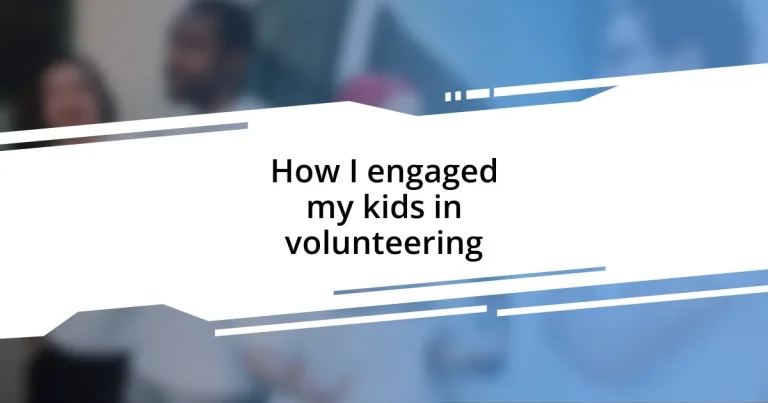Key takeaways:
- Volunteering teaches children invaluable life skills such as empathy, responsibility, and teamwork, while also fostering a sense of belonging.
- Involving kids in the decision-making process for volunteer opportunities increases their engagement and ownership of the experience.
- Making volunteering fun through themes, games, and celebrations enhances children’s enthusiasm and positive associations with service activities.
- Reflecting on volunteering experiences together deepens understanding and helps children process their feelings, reinforcing the values learned.

Understanding the Importance of Volunteering
Volunteering is more than just giving time; it experiences a powerful connection between individuals and their community. I remember the first time my children participated in a local food drive. Their excitement was palpable as they sorted through the donations, sharing snacks with volunteers and chatting with families. It struck me how fulfilling it felt to see my kids understand the impact of their efforts. Have you ever felt that energizing rush that comes from helping others? It’s a feeling I believe everyone should experience.
When kids volunteer, they not only contribute to a cause but also learn invaluable life skills like empathy and responsibility. I often find myself reflecting on how my children began to appreciate the struggles of others after joining a community clean-up event. As they picked up trash around our neighborhood, they started asking deeper questions about why it mattered. Those moments unveiled the importance of taking care of our environment—and ourselves—which I think is vital for their development.
Additionally, engaging in volunteer work fosters a sense of belonging and teamwork. I’ve noticed this firsthand during family volunteering trips; the laughter and camaraderie we share fortify our bonds. Have you ever noticed how working together on a meaningful project brings people closer? It’s amazing how such experiences can create lasting memories and a shared commitment to making a difference in the world around us.

Choosing Volunteer Opportunities Together
When it comes to choosing volunteer opportunities together, I’ve found that the process can be as rewarding as the act of volunteering itself. One weekend, my kids and I sat down to sift through local organizations. We talked about their passions—animal welfare, hunger relief, and environmental issues. It was enlightening to see them advocate for the causes they felt strongly about. How often do we give our kids a seat at the table when making such meaningful decisions?
Another time, we participated in a community gardening project. As we discussed potential projects, my kids surprised me by expressing interest in working with plants. Together, we explored local botanical gardens and conservation efforts. That collaborative decision-making allowed them to take ownership of the experience, deepening their engagement. There’s something special about having your child excitedly point out, “I chose this!” when they see their hard work come to life.
As we navigated our options, we also took into account age-appropriateness. I remember hesitating over a soup kitchen experience, worried about their comfort level and understanding. In contrast, a park clean-up suited everyone’s ability and willingness to participate without overwhelming them. We created a simple table to compare our choices, balancing excitement with logistic factors, ensuring everyone felt ready to jump in.
| Opportunity | Age Appropriateness |
|---|---|
| Community Clean-Up | All Ages |
| Shelter Volunteer | 10 & up |
| Animal Rescue | 7 & up |
| Park Gardening | All Ages |

Making Volunteering Fun for Kids
Making volunteering fun for kids is all about tapping into their interests and creativity. Last summer, we organized a backyard lemonade stand to raise funds for a local charity. My children brainstormed flavors, designed signs, and even made a playlist to keep the energy up. The joy in their faces when customers shared their favorite memories of lemonade stands as kids was priceless! That shared laughter and purpose turned a simple idea into an unforgettable experience, and I realized how powerful play and imagination can be in volunteer work.
To further enhance that fun factor, consider the following tips:
– Get Creative with Themes: Host a themed volunteering day, like “Superhero Saturday,” where kids can dress up and feel like they are on a mission.
– Incorporate Games: Link your volunteering activities to games. For example, create a scavenger hunt during a park clean-up, where kids earn points for picking up specific items.
– Celebrate Achievements: After completing a project, have a mini-celebration! Share what they learned and how they impacted others.
– Use Art: Encourage your kids to make cards or artwork for those they’re helping; it adds a personal touch to their efforts.
– Invite Friends: Sometimes, just having friends along can make the experience a whole lot more fun. Kids will remember the laughter shared just as much as the good deeds done!
Integrating fun can elevate the experience, making volunteering something kids look forward to rather than see as a chore.

Setting Clear Expectations for Kids
Setting clear expectations for kids is crucial in making volunteering a meaningful experience. I remember my first time volunteering with my children. We arrived at the food pantry, and I handed them each a task. Having a clear understanding of what I expected them to do helped alleviate any initial nervousness they had. I simply explained, “You’ll be sorting the cans and organizing them so others can find what they need.” This approach not only built their confidence but also made them feel like valuable contributors.
When expectations are well-defined, kids feel a sense of responsibility. One time, during a beach clean-up, I asked my kids to focus on collecting both trash and recyclable materials. I could see their determination grow as they searched for specific items. They even made it a game, competing to see who could find the most bottles. By clearly communicating our goals, I watched them turn what could have been a mundane chore into a fun and rewarding challenge. Isn’t it amazing how setting specific expectations can ignite that competitive spirit?
Lastly, I advocate for keeping the dialogue open. Checking in with the kids about their comfort levels during volunteering helps me gauge their engagement. I’ll often ask, “How do you feel about what we’re doing?” or “Is there anything you’d prefer to focus on next time?” This approach not only ensures they are on board but also encourages them to express their thoughts and feelings. By actively involving them in the conversation, we set a foundation of trust and shared responsibility.

Sharing Stories and Experiences
Sharing stories and experiences can truly transform the way kids perceive volunteering. One day, while we were helping at a local animal shelter, my kids and I shared some of our favorite pet stories as we cleaned out the kennels. As we laughed about their own quirky cats and dogs, I noticed how the animals’ wagging tails seemed to mirror the happiness growing in my children’s faces. It wasn’t just about the work; it was about connecting our lives to those we were helping, reinforcing the idea that we were all part of a bigger story.
I also recall a moment during a food drive when my daughter, thinking out loud, asked, “Why do we donate food, Mom?” It sparked a beautiful conversation. We shared our family’s own experiences with food scarcity and discussed why some people need help. That discussion opened her eyes to empathy, making our volunteering efforts feel far more meaningful. Have you ever noticed how a simple sharing of stories can ignite curiosity and understanding in young minds?
Lastly, I often encourage my kids to talk about their volunteering experiences with friends and family afterward. One time, they couldn’t stop recounting their day at the soup kitchen. They spoke with such passion, sharing details about the people they met and the joy of serving others. It reinforced their pride in helping the community and made them excited for our next adventure. I believe when kids share their experiences, they not only learn but also inspire others to join in on the journey. Isn’t that a wonderful ripple effect?

Reflecting on the Volunteering Experience
Reflecting on the volunteering experience often reveals unexpected lessons for both kids and parents. After one particularly challenging day at a homeless shelter, my son quietly expressed how he never realized how tough life could be for some people. His sincerity struck me; it was a moment of growth. Isn’t it incredible how volunteering can foster such deep understanding in young minds?
I’ve noticed that debriefing after each outing allows us to process emotions together. During a charity run, my daughter felt overwhelmed by the stories of those we were helping. We sat down afterward, and she bravely shared her feelings of sadness mixed with hope. I realized that acknowledging these emotions not only validated her experience but also encouraged her to approach future events with compassion. How often do we take the time to reflect on our feelings after a meaningful experience?
Each reflection session helps us strengthen our family bond. I recall how, one evening, we reviewed our recent beach clean-up and discussed the significance of each piece of trash removed. It felt rewarding when my kids recognized their individual contributions to a healthier environment. Finally, I asked them, “What impact do you think we’ve made today?” They thoughtfully recognized that every small action counts, and I couldn’t help but feel proud. Do you see how these moments can plant the seeds for lifelong values?

Encouraging Ongoing Community Engagement
Encouraging kids to stay engaged in community service requires a bit of creativity and consistency. One effective strategy I’ve used is to create a family volunteering calendar. Each month, we brainstorm different activities we can participate in, from park clean-ups to community gardens. Involving my children in this planning allows them to feel ownership and excitement. Have you ever noticed how much more invested kids are when they can help choose their own adventures?
Another approach is to connect our volunteering with their interests. For example, my son loves animals, so we’ve made regular visits to the animal shelter a staple in our routine. Each time, his enthusiasm grows as he learns about different breeds and how he’s making a difference for them. It’s fascinating how tying their passions to community service not only deepens their engagement but also teaches them responsibility. Does that resonate with your experience in encouraging kids to be community-minded?
To keep the momentum going, we also participate in follow-up events. After a soup kitchen outing, we started to return for special occasions, like holiday meals. This tradition has turned into something my kids look forward to, as they build relationships with the volunteers and beneficiaries. Each time, they come home bursting with stories and reflections on what they learned. Isn’t it rewarding to see how those connections foster a sense of belonging and commitment to the community?














